非谓语动词作定语和状语
- 格式:doc
- 大小:81.50 KB
- 文档页数:3






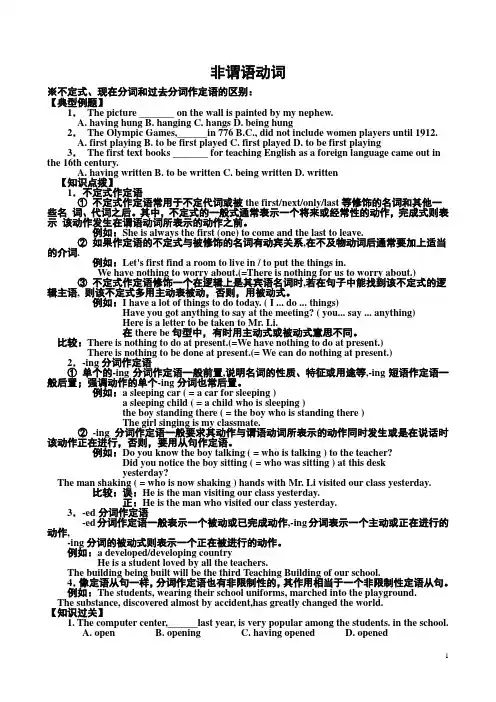
非谓语动词※不定式、现在分词和过去分词作定语的区别:【典型例题】1.The picture _______ on the wall is painted by my nephew.A. having hungB. hangingC. hangsD. being hung2.The Olympic Games,______in 776 B.C., did not include women players until 1912.A. first playingB. to be first playedC. first playedD. to be first playing3.The first text books _______ for teaching English as a foreign language came out in the 16th century.A. having writtenB. to be writtenC. being writtenD. written【知识点拨】1.不定式作定语①不定式作定语常用于不定代词或被the first/next/only/last等修饰的名词和其他一些名词、代词之后。
其中,不定式的一般式通常表示一个将来或经常性的动作,完成式则表示该动作发生在谓语动词所表示的动作之前。
例如:She is always the first (one) to come and the last to leave.②如果作定语的不定式与被修饰的名词有动宾关系,在不及物动词后通常要加上适当的介词.例如:Let's first find a room to live in / to put the things in.We have nothing to worry about.(=There is nothing for us to worry about.)③不定式作定语修饰一个在逻辑上是其宾语名词时,若在句子中能找到该不定式的逻辑主语, 则该不定式多用主动表被动,否则,用被动式。
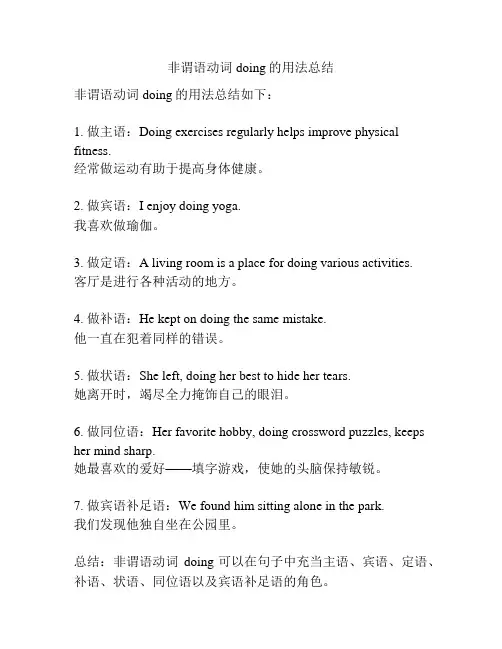
非谓语动词doing的用法总结
非谓语动词doing的用法总结如下:
1. 做主语:Doing exercises regularly helps improve physical fitness.
经常做运动有助于提高身体健康。
2. 做宾语:I enjoy doing yoga.
我喜欢做瑜伽。
3. 做定语:A living room is a place for doing various activities.
客厅是进行各种活动的地方。
4. 做补语:He kept on doing the same mistake.
他一直在犯着同样的错误。
5. 做状语:She left, doing her best to hide her tears.
她离开时,竭尽全力掩饰自己的眼泪。
6. 做同位语:Her favorite hobby, doing crossword puzzles, keeps her mind sharp.
她最喜欢的爱好——填字游戏,使她的头脑保持敏锐。
7. 做宾语补足语:We found him sitting alone in the park.
我们发现他独自坐在公园里。
总结:非谓语动词doing可以在句子中充当主语、宾语、定语、补语、状语、同位语以及宾语补足语的角色。
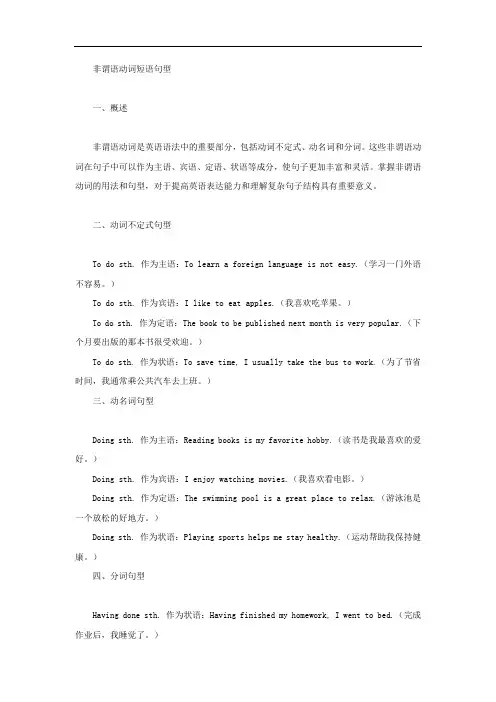
非谓语动词短语句型一、概述非谓语动词是英语语法中的重要部分,包括动词不定式、动名词和分词。
这些非谓语动词在句子中可以作为主语、宾语、定语、状语等成分,使句子更加丰富和灵活。
掌握非谓语动词的用法和句型,对于提高英语表达能力和理解复杂句子结构具有重要意义。
二、动词不定式句型To do sth. 作为主语:To learn a foreign language is not easy.(学习一门外语不容易。
)To do sth. 作为宾语:I like to eat apples.(我喜欢吃苹果。
)To do sth. 作为定语:The book to be published next month is very popular.(下个月要出版的那本书很受欢迎。
)To do sth. 作为状语:To save time, I usually take the bus to work.(为了节省时间,我通常乘公共汽车去上班。
)三、动名词句型Doing sth. 作为主语:Reading books is my favorite hobby.(读书是我最喜欢的爱好。
)Doing sth. 作为宾语:I enjoy watching movies.(我喜欢看电影。
)Doing sth. 作为定语:The swimming pool is a great place to relax.(游泳池是一个放松的好地方。
)Doing sth. 作为状语:Playing sports helps me stay healthy.(运动帮助我保持健康。
)四、分词句型Having done sth. 作为状语:Having finished my homework, I went to bed.(完成作业后,我睡觉了。
)Done sth. 作为状语:Seen from the top of the mountain, the city looks very beautiful.(从山顶看,这个城市非常美丽。
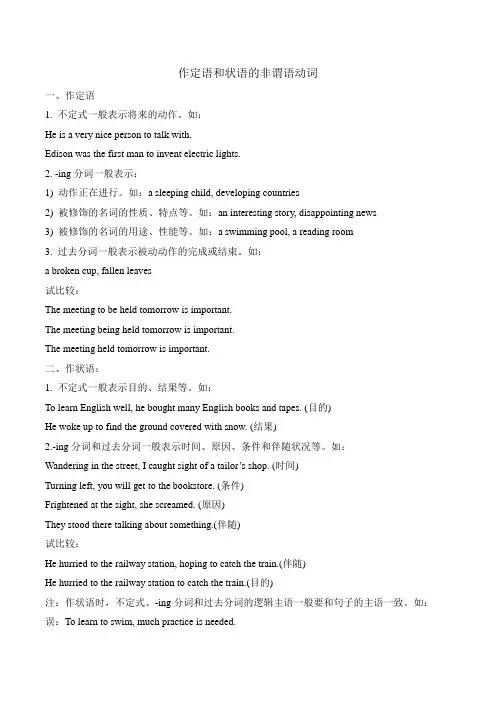
作定语和状语的非谓语动词一、作定语1. 不定式一般表示将来的动作。
如:He is a very nice person to talk with.Edison was the first man to invent electric lights.2. -ing分词一般表示:1) 动作正在进行。
如:a sleeping child, developing countries2) 被修饰的名词的性质、特点等。
如:an interesting story, disappointing news3) 被修饰的名词的用途、性能等。
如:a swimming pool, a reading room3. 过去分词一般表示被动动作的完成或结束。
如:a broken cup, fallen leaves试比较:The meeting to be held tomorrow is important.The meeting being held tomorrow is important.The meeting held tomorrow is important.二、作状语:1. 不定式一般表示目的、结果等。
如:To learn English well, he bought many English books and tapes. (目的)He woke up to find the ground covered with snow. (结果)2.-ing分词和过去分词一般表示时间、原因、条件和伴随状况等。
如:Wandering in the street, I caught sight of a tailor’s shop. (时间)Turning left, you will get to the bookstore. (条件)Frightened at the sight, she screamed. (原因)They stood there talking about something.(伴随)试比较:He hurried to the railway station, hoping to catch the train.(伴随)He hurried to the railway station to catch the train.(目的)注:作状语时,不定式、-ing分词和过去分词的逻辑主语一般要和句子的主语一致。
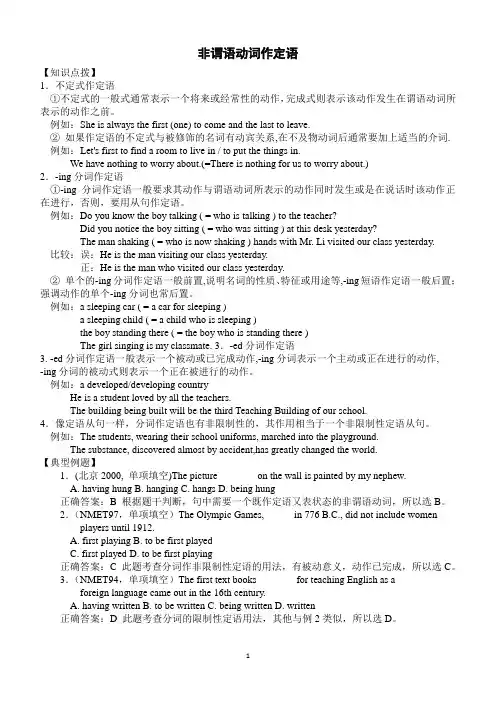
【知识点拨】1.不定式作定语①不定式的一般式通常表示一个将来或经常性的动作,完成式则表示该动作发生在谓语动词所表示的动作之前。
例如:She is always the first (one) to come and the last to leave.②如果作定语的不定式与被修饰的名词有动宾关系,在不及物动词后通常要加上适当的介词.例如:Let's first to find a room to live in / to put the things in.We have nothing to worry about.(=There is nothing for us to worry about.)2.-ing分词作定语①-ing分词作定语一般要求其动作与谓语动词所表示的动作同时发生或是在说话时该动作正在进行,否则,要用从句作定语。
例如:Do you know the boy talking ( = who is talking ) to the teacher?Did you notice the boy sitting ( = who was sitting ) at this desk yesterday?The man shaking ( = who is now shaking ) hands with Mr. Li visited our class yesterday.比较:误:He is the man visiting our class yesterday.正:He is the man who visited our class yesterday.②单个的-ing分词作定语一般前置,说明名词的性质、特征或用途等,-ing短语作定语一般后置;强调动作的单个-ing分词也常后置。
例如:a sleeping car ( = a car for sleeping )a sleeping child ( = a child who is sleeping )the boy standing there ( = the boy who is standing there )The girl singing is my classmate. 3.-ed分词作定语3. -ed分词作定语一般表示一个被动或已完成动作,-ing分词表示一个主动或正在进行的动作,-ing分词的被动式则表示一个正在被进行的动作。
高中英语语法--非谓语动词作定语,状语和补语+练习一、非谓语动词作定语1.基本形式和功能The problem discussed at the last meeting was of great importance.上次会议讨论的问题很重要。
The problem being discussed now is of great importance.现在正在讨论的问题非常重要。
The problem to be discussed at the next meeting is of great importance.下次会议要讨论的问题很重要。
2.ability,chance,idea,fact,attempt,moment,way,right等词后常接不定式作后置定语。
We promise whoever attends the party a chance to have a photo taken with the movie star.我们向参加聚会的人保证有机会和这位电影明星合影。
Do you have the ability to read and write in English?你有英文读写能力吗?二、非谓语动词作状语1.不定式作状语(1)不定式作目的状语也可以构成“so as to do”或“in order to do”的结构。
但so as to do不可置于句首。
不定式作目的状语置于句中时不可用逗号和句子隔开。
Her mother plans to fly to Beijing at least four times a year so as to/in order to visit her.为了看望她,她母亲计划每年至少乘飞机去北京四次。
In order not to forget,Bob wrote down my number.为了不忘记,鲍勃写下了我的号码。
(2)不定式作结果状语。
高考英语语法考点讲解与练习一、非谓语动词作定语【知识要点】1、非谓语动词包括四种:-to do不定式,-ing分词,-ed分词和动名词。
(重点为前三种)2、非谓语动词的词性及句法功能①-to do不定式相当于名词、形容词和副词,可以在句子中充当主语、宾语、表语、定语、状语和宾语补足语;②-ing分词相当于形容词和副词,可以在句子中充当表语、定语、状语和宾语补足语;③-ed分词相当于形容词和副词,可以在句子中充当表语、定语、状语和宾语补足语;④动名词相当于名词,可以在句子中充当主语、宾语、表语和定语。
3、前三种非谓语动词的形式与意义① -ing分词的基本意义为:主动或进行,变形有:进行式:doing被动式:being done完成式:having done完成被动式:having been done②-to do不定式的基本意义为:主动将来,变形有:进行式:to be doing被动式:to be done完成式:to have done完成被动式:to have been done③-ed分词表示被动或完成。
4、非谓语动词作定语由于三种非谓语动词都具有形容词的性质,所以它们都可以在句子中充当定语,并根据其在被修饰的名词中心词的前后位置,分为前置定语和后置定语两种。
the falling leaves (-ing分词作前置定语,“正在下落的叶子”)the leaves falling in the sky (-ing分词短语作后置定语,“正在空中下落的叶子”)the coming/following day (-ing分词作前置定语,“第二天”)the day to come (-to do分词短语作后置定语,“第二天”)the fallen leaves (-ed分词作前置定语,“已经落地的叶子/落叶”)the house burnt to the ground (-ed分词短语作后置定语,“被烧成废墟的房子”)【练习】单句语法填空1.Looking at the ______ (fall) leaves in the sky, he knows the fall is coming.2.Seeing the ______ (fall) leaves on the ground, he decided to do some sweeping first before sitting down to have a rest.3.It is said that the building ______ (build) here next year will be completed within one year.4.It is said that the building ______ (build) here now will be completed within one year.5.It is said that the building ______ (build) here last year will be rebuilt soon.6.The gentleman ______ (seat) next to Tom is his best friend.7.The gentleman ______ (sit) next to Tom is his best friend.8.The room was in a mass, with those ______ (break) furniture.9.The purely white snow looks like a beautiful blanket ______ (cover) the land.10.The police have got enough evidence ______ (prove) that he is guilty.11.Turn to the right and you will see a wide road ______ (lead) up to the building.12.If you get the first place, you will win an all expenses ______ (pay) journey.13.All the ______ (question) people supported the government’s latest policy.14.You should keep well the books ______ (borrow) from the library.15.Can those people ______ (seat) at the back hear me?二、非谓语动词作状语【知识要点】非谓语动词作状语由于三种非谓语动词都具有副词的性质,所以它们都可以在句子中充当状语。
区分不定式作定语和状语不定式是英语中的一种非谓语动词形式,由"to + 动词原形"构成。
在句子中,不定式可以作为定语或状语,起到修饰名词或动词的作用。
本文将从不定式作为定语和状语两个方面进行区分讨论。
一、不定式作为定语不定式作为定语通常修饰名词或代词,用于说明名词或代词的用途、目的或性质等。
不定式作为定语时,常位于被修饰名词的前面或后面。
1. 位于名词前面的不定式作定语在这种情况下,不定式一般用来说明名词的用途、目的或性质。
例如:- I have a book to read.(我有一本书可读。
)- She needs a pen to write.(她需要一支笔来写作。
)- He has a car to drive.(他有一辆车可以开。
)在这些例子中,不定式to read、to write和to drive修饰名词book、pen和car,说明它们的用途或目的。
2. 位于名词后面的不定式作定语在这种情况下,不定式用于说明名词的性质或特征,常表示名词的所属关系。
例如:- The book to read is on the shelf.(可读的那本书在书架上。
)- The person to talk to is the manager.(要找的那个人是经理。
)- The place to visit is Paris.(值得去的地方是巴黎。
)这些例子中,不定式to read、to talk和to visit修饰名词book、person和place,表示它们的性质或特征。
二、不定式作为状语不定式作为状语通常修饰动词,用于说明动作的目的、结果或方式等。
不定式作为状语时,常位于句子的谓语动词后面。
1. 不定式作目的状语不定式作目的状语时,说明动作的目的或意图。
例如:- He went to the supermarket to buy some groceries.(他去超市买了些杂货。
非谓语动词做定语:1. The chair looks rather hard, but in fact it is very comfortable to __________.A. sitB. sit onC. be satD. be sat on2. I’m not sure which restaurant ___________.A. to eat onB. eating atC. to eat atD. for eating3. ---“What do you think of this middle school?”---“It is a very good ___________.”A. school to studyB. school to study inC. studying schoolD. school for children to study4. ---“I’d like to buy an expensive camera.”---“Well, we have several models ___________.”A. to choose fromB. of choiceC. to be chosenD. for choosing5. The doctors are trying their best to save the ____ woman. A. dead B. death C. dying D. died6. He loves parties. He is always the first __________ and the last __________.A. coming, leavingB. to come, to leaveC. comes, leavesD. come, leave7. Before he had no chance __________.A. to go to schoolB. to go schoolC. going to schoolD. to go to the school8. Now the need __________ other people’s language is becoming greater and greater.A. to learnB. learningC. to be learnedD. being learned9. This is an important matter. I need at least a day or two __________.A. of thinking over itB. to think it overC. of thinking it overD. to think over it10. It is time __________ wheat.A. for sowB. of sowingC. to sowD. to sowing11. “Do you have any clothes __________ today?” the maid asked.A. to washB. to be washedC. washD. be washed12. Girls under ten are able to take part in this activity ______ for them.A. having designedB. designingC. to designD. designed13. This book can be used in __________ countries.A. English-speakingB. English-spokenC. English-spokeD. English-speak14. At present, English is the main subject ___________ here.A. to be taughtB. being taughtC. teachingD. to be teaching15. Snow was falling when they went along a mountain path __________ to the front.A. to leadB. ledC. leadingD. being led16. ---“Who are those people with the banner?”---“A group ______ itself the League for peace.”A. callingB. callsC. calledD. is called17. “The picture writing” __________ long long ago is hard for us to understand today.A. having been drawnB. being drawnC. was drawnD. drawn18. The noise _____ by the machine could be heard at night.A. makingB. madeC. makeD. to be made19. The students, _____ at the way the questions were put, didn’t know the answers to them.A. they surprisingB. surprisedC. their being surprisedD. surprise20. The pen __________ belongs to me.A. which it is on the tableB. lying on the tableC. is on the tableD. which on the table非谓语动词做状语的区别:1. This dish cloth is ______ for me to dry the dishes. A. so wet B. wet enough C. as wet D. too wet2. The house is much too small __________.A. for us to liveB. for us to live inC. that we can’t liveD. that we can’t live in3. The light was strong enough __________.A. read by B. to read by C. read under D. to read4. H didn’t speak slowly enough __________.A. every one understood B. for everyone understoodC. for everyone to understandD. for everyone to be understood5. Would you be __________ to show me the way to the City Hall?A. good enoughB. good enough asC. so goodD. as good as6. He was so foolish __________ his car unlocked.A. to leaveB. that leaveC. as to leaveD. for him to leave7. Napoleon spoke so loudly as to __________ in front of his soldiers.A. hearB. be heardC. listenD. be listened8. Do you think him easy __________.A. to get along withB. to get alongC. to be got along withD. to be got along9. The water is good __________.A. to drink itB. to be drunkC. to drinkD. at drinking10. His speech in English was difficult __________ .A. in followingB. for being followedC. to followD. to be followed by11. Good-bye, Mr Jones. I’m pleased __________.A. for meeting youB. to meet youC. to have been meeting youD. to have met you12. I have enjoyed my visit here. I’ll be very sorry __________.A. for leavingB. of leavingC. to leaveD. left13. I spoke to him kindly _________ him.A. to not frightenB. so as not to frightenC. in order to not frightenD. for not frightening14. Tom is waiting __________ the doctor. A. to see B. for to see C. for seeing D. for see15. I went to see him __________ him out. A. finding B. find C. only to find D. only found16. _________, one needs much practice. A. To learn swimming well B. To learn to swim wellC. Swimming to be learned wellD. Learning swim well17. __________, I don’t like her sister.A. Telling the truthB. Been told the truthC. To tell the truthD. To tell the true18. __________ for several weeks, the city was short of food and clothing.A. As having floodedB. As floodingC. Having been floodedD. to flood19. __________ tomorrow’s lessons, I have no time to go out with you.A. Not preparingB. Not prepareC. Not being preparedD. Not having prepared20. _________ from the tallest building, the whole city looks very beautiful..A. SeeB. SawC. SeeingD. Seen21. Look around when ___________ the street. A. across B. crossing C. crossed D. to be crossing22. We walked as fast as we could, __________ to catch the 9:30 train.A. hopingB. to hopeC. we hopedD. being hoped23. ___________ the past, our life is much better.A. Comparing withB. Be compared withC. To compare withD. Compared with24. __________ the cry for help, people immediately rushed out of the rooms.A. To hearB. HearingC. Having heardD. They hearing25. It __________ heavily, the outing had to be put off.A. being rainedB. being rainingC. rainingD. rains26. The sun __________, they went home. A. set down B. setted C. setting D. sets27. __________ the concert began.A. The listeners having taken their seatsB. Having taken their seatsC. Have taken their placesD. The listeners to have taken their places28. __________ Hello, he reached out his hand. A. Said B. Saying C. Talked about D. Talking to29. He rushed into the room, __________.A. with sweat drippingB. sweat drippedC. dripped sweatD. sweated30. __________, I went out for a walk. A. There was nothing to do B. There being nothing to doC. There had nothing to doD. There were nothing to do答案:1 BCBAC 6 BAABC 11 BDABC 16 ADBBB答案:1 DBBCA 6 CBACC 11 DCBAC16 BCCDD 21 BADBC 26 CABAB。
一.非谓语动词※不定式、现在分词和过去分词作定语的区别:【知识点拨】1.不定式作定语①不定式作定语常用于不定代词或被the first/next/only/last等修饰的名词和其他一些名词、代词之后。
其中,不定式的一般式通常表示一个将来或经常性的动作,完成式则表示该动作发生在谓语动词所表示的动作之前。
例如:She is always the first (one) to come and the last to leave.②如果作定语的不定式与被修饰的名词有动宾关系,在不及物动词后通常要加上适当的介词.例如:Let's first find a room to live in / to put the things in.We have nothing to worry about.(=There is nothing for us to worry about.)③不定式作定语修饰一个在逻辑上是其宾语名词时,若在句子中能找到该不定式的逻辑主语, 则该不定式多用主动表被动,否则,用被动式。
例如:I have a lot of things to do today. ( I ... do ... things)2.-ing分词作定语①单个的-ing分词作定语一般前置,说明名词的性质、特征或用途等,-ing短语作定语一般后置;强调动作的单个-ing分词也常后置。
例如:a sleeping car ( = a car for sleeping )a sleeping child ( = a child who is sleeping )the boy standing there ( = the boy who is standing there )The girl singing is my classmate.②-ing分词作定语一般要求其动作与谓语动词所表示的动作同时发生或是在说话时该动作正在进行,否则,要用从句作定语。
例如:Do you know the boy talking ( = who is talking ) to the teacher?Did you notice the boy sitting ( = who was sitting ) at this deskyesterday?3.-ed分词作定语-ed分词作定语一般表示一个被动或已完成动作,-ing分词表示一个主动或正在进行的动作,-ing分词的被动式则表示一个正在被进行的动作。
例如:a developed/developing countryHe is a student loved by all the teachers.The building being built will be the third Teaching Building of our school.4.像定语从句一样,分词作定语也有非限制性的,其作用相当于一个非限制性定语从句。
例如:The students, wearing their school uniforms, marched into the playground.The substance, discovered almost by accident,has greatly changed the world.【知识过关】1. The computer center,______last year, is very popular among the students. in the school.A. openB. openingC. having openedD. opened2. Most of the artists _______ to the party were from South Africa.A. invitedB. to inviteC. being invitedD. had been invited3. There was a terrible noise _______ the sudden burst of light.A. followedB. followingC. to be followedD. being followed4. Do you know the boy_______ under the big tree?A. layB. lainC. layingD. lying5. Are you going to attend the meeting _______ tomorrow?A. to be heldB. being heldC. will be heldD. held※、不定式作定语不定式作定语一般有以下四种情形:⑴用于个体名词后,被修饰的名词作不定式的逻辑宾语, 同时句子的主语也是不定式动作的执行者。
这种情况下使用不定式的一般体:[例题]I can’t find a chair ________.A. to sitB. for to sit onC. to sit onD. for sittingI’m not sure which restaurant _______.A. to eat atB. eating atC. to eat onD. for eating⑵用于个体名词后,被修饰的名词作不定式的逻辑宾语, 但强调的是不定式动作的执行者、发生的时间或地点时,用不定式一般体的被动形式:例题FIFA has named the 36 referees for the 2012 FIFA World Cup _____ by South Korea and Jap an.A. to be co-hostedB. co-hostedC. being co-hostedD. co-h题 What countries do you think will be represented at the six-side peace talk ______ in Beiji ng next month?A. to holdB. holdingC. being heldD. to be held⑶用于个体名词后,和被修饰的名词作不定式的逻辑主语:[例题]She is the first person ________ the idea.A. think ofB. thinking ofC. to think ofD. thought ofThis report is urgent. We need someone ______ with the typing.A. helpingB. to helpC. helpedD. to be helped※、现在分词作定语现在分词作定语时,要注意分词所表示动作发生的时间。
大体说来,有下面两种情况:⑴分词表示正在进行的动作,改为定语从句时要用进行时态:[例题]I don`t know the man ________ over there.A. to standB. standingC. stoodD. being stoodIt seems that I once met with the man _____ us.A. servedB. being servedC. to have servedD. serving⑵如果分词和被修饰名词呈现被动关系,而且,所指动作此刻正在发生,或者是和谓语所表示的动作同时发生,就用现在分词一般体的被动形式:[例题]The old man _______ has been ill for months.A. to operate onB. operate onC. operatedD. being operated onThe Three Gorge project ______now on the middle reaches of Yangtse River is the biggest d am of its kind.※、过去分词作定语过去分词作定语时,分词表示的动作不仅和所修饰的名词呈被动关系,同时,要么发生于谓语动作之前,要么没有一定的时间性:[例题]From the dates ____ on the gold coin, we decided that it was made five hundred years ago.A. markingB. markedC. to be markedD. having been marked[例题]Any applicant form ______ properly will not be accepted by the company.A. not filledB. not to be filledC. not being filledD. not having been filled[例题]The amount of money _____ for the seriously sick child was soon collected.2.-ing分词和-ed分词作状语① -ing分词和-ed分词作状语修饰谓语,多说明动作发生的背景、方式或伴随情况。
如果在逻辑上句中的主语与分词有主谓关系,用-ing分词,有动宾关系则用-ed分词。
例如:We enjoyed ourselves in the park, singing and dancing.Built in 1900, the house is now 100 years old.② -ing分词和-ed分词都可作原因或时间状语, 其作用相当于一个相应的状语从句。
如果在逻辑上句中的主语与分词有主谓关系,用-ing分词,有动宾关系则用-ed分词。
例如:Being so poor in those days, they couldn't send the boy to school.(原因)Born in a poor family, the boy could not go to school. (原因)3.-ing分词有时可作结果状语。
例如:Her husband died in the war, leaving her a widow with three children.We got up very early, arriving at the hospital ahead of time.4.-ed分词有时用作条件状语,其作用相当于一个条件状语从句。
例如:Given more time, we could have done it much better.【知识过关】1. She set out soon after dark _______ home an hour later.A. arrivingB. to arriveC. having arrivedD. and arrived2. "Can't you read?" Mary said _______ to the notice.A. angrily pointingB. and point angrilyC. angrily pointedD. and angrily pointing3.不定式作原因状语用作原因状语的不定式一般放于句末,偶尔也见于句首。